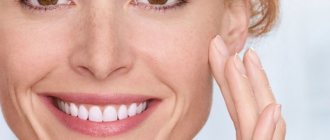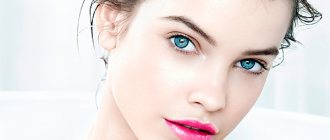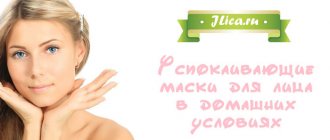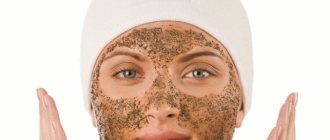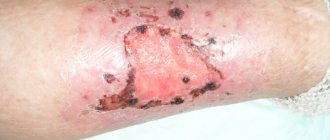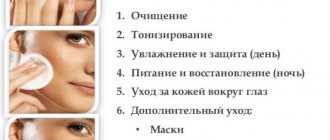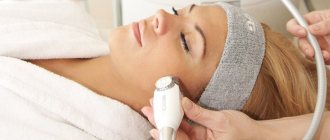Any exfoliation activates the natural regeneration process, promotes the production of collagen fibers, normalizes blood circulation and fills dermal cells with necessary oxygen.
But do not forget that after cleansing the face is exposed to the negative effects of external factors, so it is important to follow the recommendations for caring for the epidermis during the recovery period. Ignoring advice on skin regeneration can lead to side effects and deterioration of the original condition of the dermis.
What not to do after cleaning
When caring for facial skin after cleansing at home or in a salon, the following is prohibited:
- Wash your face with warm water for 24 hours - such a procedure will provoke the production of subcutaneous sebum and can cause clogged pores. You should also minimize contact of the epidermis with your hands - this increases the risk of infection in the deep layers of the skin and, as a result, contributes to the appearance of ulcers.
- During the first few days you will be outside for a long time - sudden changes in temperature, excessive humidity or exposure to ultraviolet rays can lead to severe peeling and the appearance of dark spots.
- Go to a bathhouse, sauna or gym for 7–14 days - increased sweating can lead to the spread of infection through the skin.
- Swimming in open water or a pool for several weeks - contact with water often causes the introduction of harmful microorganisms into the affected skin.
- Apply makeup for 3-5 days after cleansing your face - using foundation and other decorative cosmetics can lead to clogged pores and the appearance of sebaceous plugs.
- Use scrubbing compounds for 5-10 days - this will cause severe redness, peeling and the appearance of wounds.
- When washing your face, use soap - this will lead to severe peeling and a feeling of tightness.
- Removing crusts from the face on your own will increase the duration of rehabilitation and lead to the appearance of scars.
The question that many people are interested in is whether it is possible to drink alcohol after exfoliation, one can safely answer no, since alcoholic drinks contribute to the appearance of swelling and dry out the skin.
In addition, it is recommended to exclude sweets, smoked and spicy foods from the diet, as they increase the rehabilitation process. Before the end of the recovery period, you should not tattoo your lips or eyebrows, so as not to aggravate the condition of the skin.
When there is nothing to worry about: unpleasant, but normal
Immediately after the procedure, you may notice normal but unpleasant symptoms:
- Redness, especially after manual cleaning, is partially removed with masks. But the phenomenon completely disappears after 24-48 hours. Rene Rouleau, a stellar cosmetologist, speaks about the cause of redness: “In general, if the skin is well softened, the pores are cleaned without difficulty. Redness appears to be minimal. But in practice, when a cosmetologist has to manually remove a comedone, the appearance of redness is normal. Especially if the sebaceous plugs or blackheads with black heads were deep and dense.”
- The skin may appear pink for several hours after cleansing. Rouleau says your face shouldn't look like you have a flare-up. But increased blood circulation after massages and cleansing is a common situation.
- Rashes that appear after the procedure will also not be an alarming sign. After all, all processes in the skin are activated, and the pores begin to cleanse themselves. During peelings or manual extraction, the cosmetologist-dermatologist does not set a goal to remove plugs at any cost. After all, some of the pollution will come out naturally! When the exacerbation is behind you, your face will look better than before cleansing.
- The feeling of tightness after chemical peels is due to the skin being exposed to acid. Although the dermatologist applies a moisturizing and nourishing cream, increased dryness remains the norm. With deep peelings, you even have to put up with peeling: the main thing is not to tear off the crusts!
Most of these phenomena do not require additional intervention. A cosmetologist can also recommend remedies to reduce side effects.
When to rush to the doctor
The consequences of cleansing can be more serious:
- If after cleansing your face you are wondering how many days the redness will go away and do not see any improvement within 48 hours, contact a cosmetologist-dermatologist.
- Burning, sensitivity, swelling and redness after dry cleaning may indicate that the action was too strong.
- Irritation, peeling of the skin, bright redness, cough, and sometimes swelling in the neck are signs of individual intolerance. Even the famous Renee Rouleau admits that one of her clients had a similar reaction to the herbal extract.
- Excessive rashes can be a consequence of incorrect choice of products, infection, or use of expired products.
To avoid unpleasant consequences, contact salons with a proven reputation.
Care after facial cleansing
Tips for caring for your face after cleansing at home or with a cosmetologist:
- Throughout the entire recovery period, you should treat your face with delicate nourishing products. Mixtures containing alcohol can be applied locally to inflamed areas.
- To relieve inflammation, the skin should be rinsed with decoctions of chamomile, plantain, calendula or St. John's wort. Herbal compresses will also help relieve irritation and swelling in a short time.
- 1-3 days after exfoliation, wash with melt or mineral water - this will help reduce the risk of spreading the infection. Adding two drops of lemon juice or apple cider vinegar to high-quality water will help even out your complexion and activate regeneration processes at the cellular level.
- For a speedy recovery, you need to apply a cream selected daily, taking into account the type of dermis, to your face, which has a nourishing and moisturizing effect. Before going outside, you should use a product with a high level of protection against ultraviolet rays - this will prevent the appearance of peeling and age spots.
2-3 days after cleansing, mesotherapy or biorevitalization is allowed, provided that there is no inflammation on the cleansed skin. Additional peelings to tighten pores, eliminate greasy shine and various rashes can be done no earlier than a week after exfoliation.
After salon cleansing, the cosmetologist treats the epidermis with a soothing mask, which helps to quickly get rid of redness after cleansing the facial skin, and selects an individual course of care for the recovery period, depending on the type of cleansing.
After mechanical cleaning
Manual exfoliation is the most traumatic technique; after it, in addition to the general rules for caring for the epidermis, it is recommended to adhere to specific recommendations:
- treat the dermis with mild agents with an antiseptic effect;
- remove excess subcutaneous fat with natural tonics without alcohol;
- When new rashes appear, apply Metrogyl gel to them 2 times a day.
You can use medications only if complications occur and only after consulting a specialist.
After vacuum cleaning
After cleansing with a vacuum, you should treat your face daily with products with a moisturizing, soothing and nourishing effect - this will help get rid of puffiness and red spots. If bruises appear after the procedure, a cosmetologist should choose a method for eliminating them.
After ultrasonic cleaning
After ultrasonic exfoliation, you need to make masks with cosmetic clay selected for the type of dermis and seaweed once every 3 days throughout the entire rehabilitation period - this will help moisturize the skin and saturate it with useful microelements. It is necessary to use sunscreen for 3-4 weeks.
After laser cleaning
After laser peeling, you should not wash your face for 4–6 days; during this period, only alcohol-free toners can be used to remove impurities. It is necessary to avoid scrubbing agents for a month so as not to damage the healthy layers of the epidermis.
At home, a few days after cleansing, it is recommended to use the following natural healing masks:
- Bodyaga - helps get rid of bruises and minor hematomas. The product is applied to problem areas and removed with warm water after 5–15 minutes. Not recommended for use by those with dry skin.
- Egg-lemon. Mix egg white and a few drops of lemon juice and apply to skin - helps even out skin tone and tighten pores.
- Cucumber. Rinse your face with warm water and apply the vegetable slices to your face, leave for 30–50 minutes. The mask helps saturate the dermis with essential microelements, eliminates swelling and redness.
- Sour cream. Rub sour cream into the skin along massage lines, rinse after 30–40 minutes. The product helps get rid of flaking.
Masks are allowed to be used no more than 2 times a week. Before the first application, you should do an allergy test - for this, a small amount of the prepared mixture is distributed on the bend of the elbow and left for 15-25 minutes. If during this period of time there is no strong burning sensation, feeling of tightness, itching and severe redness, you can use the mixture for its intended purpose.
Advice from experienced doctors and cosmetologists
Soothing masks
The specialist’s recommendations after cleansing the face will help prevent the occurrence of unpleasant consequences in the post-period:
- It is necessary to use antiseptics - iodine, chlorhexidine to treat acne or inflammation that occurs during the recovery process.
- Soothing masks and aloe vera gel are great for reducing redness.
- Spots caused by vascular injury should be gently massaged with aloe vera gel.
- A suitable moisturizer will eliminate the discomfort.
- A clay mask based on mineral water will help care for small wounds.
- Before going outside, you need to lubricate your face with antiseptic lotion and salicylic ointment.
- Aloe vera gel and Panthenol have proven themselves in the fight against burns.
- Peeling will go away if you constantly use super moisturizers and make moisturizing masks.
- Bruises and bruises appear quite rarely. In this case, it is advisable to consult a doctor.
After cleansing, the face needs careful care, not only if side effects occur. Even in their absence, care during the post-period is one of the prerequisites for success.
To make your face happy with its freshness and beauty after cleansing, it is enough to follow the specified recommendations and advice from the specialist. Everything depends not only on the experience and competence of the cosmetologist, but also on proper care during the recovery period, as well as a good mood and the desire to work on your own appearance!
Complications
Possible complications after cleaning:
- The appearance of red spots, bruises or bruises is a consequence of excessive intensity of the procedure or too thin skin.
- Rashes should not be squeezed out so as not to provoke the spread of infection. Acne should be wiped with chlorhexidine or Baneocin.
- Inflamed acne appears due to the removal of ulcers during cleansing or improper rehabilitation care. To eliminate them, it is necessary to use antibacterial ointments.
- Peeling occurs due to the removal of the stratum corneum of the dermis. To get rid of it as quickly as possible, you need to use delicate moisturizers.
- Swelling often appears after acne removal and can last from 2 to 7 days.
With proper skin care after cleansing, the above side effects disappear on their own within a week. If during this time the appearance and condition of the skin has not improved, you should be examined by a doctor.
In the case of exfoliation of skin with the presence of ulcers, there is a risk of infection spreading, which leads to aggravation of the inflammatory process. The appearance of new ulcers may be accompanied by an increase in body temperature - in this case, it is necessary to undergo an examination by a doctor and take a course of antibiotics.
Self-removal of inflamed rashes can cause post-acne, scars and dark spots. After complete restoration of the dermis, you can get rid of such side effects using mesotherapy or physiotherapy.
Failure to follow the rules for caring for cleansed epidermis can cause clogged pores and the appearance of blackheads. Repeated exfoliation will help solve this problem.
Summing up
According to reviews from my patients, if facial cleansing was done efficiently and carefully, and home care was competent, skin problems do not arise after it. I will once again emphasize the importance of disinfection on the first day and the use of soft, purified water. The presence of heavy metal salts, rust particles and pathogenic microorganisms in it mainly causes facial irritation and the appearance of new acne.
You need to understand that how long the skin will be in good condition after the procedure also largely depends on its care. Cleaning does not solve dermatological problems. If pimples and acne appear regularly, you need to look for and eliminate the causes. Not even every cosmetologist can do this quickly. Therefore, it is also worth consulting with a dermatologist, and sometimes undergoing a series of tests and undergoing a course of treatment.
Side effects of the procedure
After most types of cleansing, a number of side effects are observed on renewed facial skin:
- Rashes. Inflamed pimples appear due to infection.
- Red spots mean that during cleansing the surface vessels were damaged or the water balance in the skin was disturbed.
- Small wounds most often appear after mechanical peeling at the sites of comedones.
- Peeling occurs due to the removal of the dead layer of the dermis.
- Burns appear after laser exfoliation due to an incorrect procedure or individual characteristics of the body.
- Bruising may occur after vacuum or manual peeling due to capillaries located close to the surface layer of the skin.
After any cleaning, redness is observed - this is a normal reaction of the body and the side effect will go away on its own in a few days.
There are two main types of makeup
- Everyday, where the desire to decorate yourself and highlight the advantageous aspects of your appearance completely coincides with the modern capabilities of decorative cosmetics manufacturers and training seminars where you will be taught how to do makeup without makeup and draw eyebrows beautifully;
- Dermatological camouflage. As noted by Professor E.R. Arabian (Clinical Dermatology and Venereology. 2007), the so-called camouflage cosmetics, or corrective cosmetics, are widely used at present. The purpose of its use is to disguise pronounced defects in open areas of the skin: face, neck, hands. Thus, camouflage cosmetics are indicated for patients with congenital and acquired pigmentation disorders (vitiligo, albinism, melasma, post-inflammatory hyper- and hypopigmentation, nevi, etc.), acne, scars and cicatricial atrophy, vascular skin diseases (hemangiomas, rosacea) and other conditions . In cosmetology, such products are prescribed for persistent facial erythema and other complications after medium and deep chemical peels, laser resurfacing and dermabrasion. Also important is the ability to disguise tattoos and permanent makeup that is inadequate from an aesthetic point of view. An example of camouflage cosmetics is the ultra-resistant corrective system Dermablend (VICHY Laboratories, France), which includes an intensive camouflaging corrective base and fixing powder to complete the makeup.

